 Swingtime on the Bay
Swingtime on the BayEverybody’s Doing It. Why Not You?
 Swingtime on the Bay
Swingtime on the BayRock step, tuck, turn, rock step, and kick and kick and kick.
Chesapeake Country is speaking a new language: the language of swing.
On a recent Wednesday night at Surfside 7 in Edgewater, novice and experienced
Lindy hoppers gathered again to dance that language.
As instructors Gay and Dave Shepardson called out the steps, students
intently swiveled their bodies and kicked their legs but not their partners.
Skilled Lindy hopper Katrina Hegge patiently guided a series of less experienced
partners through the  movements. Hegge, of Edgewater,
dances two or three times a week. "I just love the movement and the
music," she says. Moving to the music: That's what swing is all about.
movements. Hegge, of Edgewater,
dances two or three times a week. "I just love the movement and the
music," she says. Moving to the music: That's what swing is all about.
These energetic folk are joining thousands throughout the country in learning how to swing that swing. With the revival of not just Lindy Hop from the '20s but also of East Coast swing, West Coast swing and DC Hand Dancing from the '30s, '40s and '50s, dancers of all ages are cutting new rugs while staying fit. They're having fun while making new connections to people, to music, to their own bodies.
Speaking the Language
If we're still not speaking your language, the first step may be a lesson in definition.
The Lindy Hop originated in Harlem in 1927, the year Charles Lindbergh hopped over the Atlantic in his solo flight. Celebrated around the world, Lindy's soaring triumph added an extra burst of energy to the already Roaring '20s. Today, the Lindy has returned to the top of dance's popularity cycle. Energizing the fad this time around were the high-flying dancers of The Gap's televised clothing ads and the 1996 independent film Swingers.
Lindy Hop follows an eight-beat rhythm count as the paired dancers circle on the floor in a clockwise direction. For much of the Lindy, dancers join in a closed position, with one hand on the other's shoulder or waist, the other hands linked. But Lindy, like its namesake, is definitively airborne, as dancers soar with aerials, jumps and kicks. In the "front straddle,' one of Lindy's most popular moves, the gentleman grasps the lady's waist, picks her up and pulls her toward his waist, where she straddles his torso.
Even beginning Lindy hoppers can master the side-by-side kick of the
Charleston, another favorite Lindy move. Lindy is the most aerobic of the
swing styles; to Lindy Hop, you either have to be in good physical shape
or be willing to get there fast.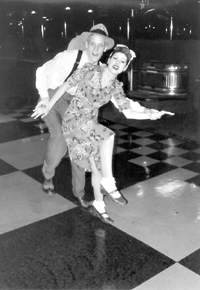
Much of the older crowd (we're talking 30s and up) finds East Coast swing more appealing than Lindy Hop. A more freeform style of swing done without the aerials of Lindy, East Coast is the jitterbug of World War II dance halls. If you can't remember that, picture movies with the Andrew Sisters singing about their bugle boy. In front of the vocalists, young Americans crowded the dance floor, hand in hand, twirling and turning. Jitterbug offered a respite from the horrors and insecurity of the war.
East Coast jitterbug, a more grounded style, is usually danced without any aerials but with lots of turns. Jitterbug follows a six beat count, and as in Lindy, dancers move in a circular pattern to up-tempo music. Some dancers of East Coast vary the style, some using a bouncy or springy step. Others value the smooth and flowing quality of their movements. The jitterbug rhythm is varied by being danced in single, double or triple time, depending on the tempo of the music (beats per minute). If you're a newcomer to swing, this is probably the place to start. The steps are simple, and once you've learned them, you can dance all night to all kinds of music.
West Coast swing, a relative newcomer in swing styles, originated in crowded West Coast clubs in the '50s. The lack of space in those clubs called for tight movements taking a minimum of floor space. West Coast swing is based on a six- or eight-count rhythm, depending upon the moves and the music. Dancers perform its complex patterns in a back and forth slot configuration, making for a tidy dance floor with (hopefully) room for everyone.
The lady moves back and forth along the slot while the gentleman moves out of her way while leading her into spins, turns and whips. For the lady, West Coast swing requires balance and the ability to spin multiple times. For the gentleman, this dance style requires allowing the lady to have the spotlight.
West Coast is a lady's dance. When she arrives at the end of the slot, the lady may perform some syncopations, quick intricate foot movements. Or she may do body rolls, flexing her body, vertebrae by vertebrae. If she has long hair, she'll toss it around. Ladies, if you've been looking for a safe place to lose your inhibitions and expose your seductive, sultry side, this is your dance. It's smooth, it's sensual and it's hot.
If you prefer cool to hot, check out DC Hand Dancing, a local swing genre. DC Hand Dancing joins West Coast as one of the more tightly patterned styles developed in close quarters. Those close quarters were primarily living rooms in the African American community in Washington, D.C., during the '50s.
Like West Coast swing, DC Hand Dancing depends upon a six- or eight-count rhythm. Dancers follow a slot configuration, but here the slot is a circular one. The name comes from the complicated hand patterns used by the gentleman to move the lady around him in a counter-clockwise circle. In this swing style, it's the hands, not the feet, that are flashy.
DC Hand Dancing showcases the gentleman rather than the lady. He exhibits his talent with complex, artistic hand movements while always staying in touch with and keeping his lady in motion. Just watch a couple of good DC Hand dancers to witness a true definition of "cool."
Lindy, East Coast, West Coast, DC Hand Dancing: All are back in style. You'll find each swing style has its own appeal. You may want to check them all out before you decide which one suits your style.
Swinging Fit
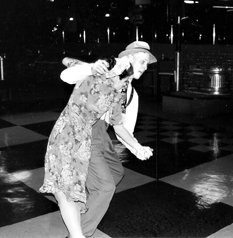 "Swing dancers are having such
a good time that they don't realize they are exercising," says Andrew
Freedman, general manager of the Merritt Athletic Club in Annapolis. "It
gives people the motivation to have fun getting into shape."
"Swing dancers are having such
a good time that they don't realize they are exercising," says Andrew
Freedman, general manager of the Merritt Athletic Club in Annapolis. "It
gives people the motivation to have fun getting into shape."
To introduce club members to this different way to be social and stay fit -- and to attract new interest -- Freedman began in January offering ballroom and swing dances. He hopes the events become a monthly tradition. Join in at Merritt's next dance Friday, March 19 from 7-9:30pm.
At Merritt's first swing dance, the apprehensive beginners joined more experienced dancers for a lesson and a couple hours of social dancing. By the end of the evening, apprehensions had evaporated -- along with hundreds of calories. In jiving their way through the fundamentals of single-step East Coast Swing, the dancers each lost 600 or 700 calories from the aerobic maneuvers. That's three bagels. Or two cups of Ben & Jerry's ice cream (for some folks, a traditional snack after dancing).
In addition to burning calories, swing dancing gets your muscles in shape. You'll be reaching, stretching, bending, kicking: all those movements that tone and sculpt your body but can seem boring when done at home or at the gym. As Freedman suggested, "Swing dancing is for those who don't like lifting weights or running on the treadmill."
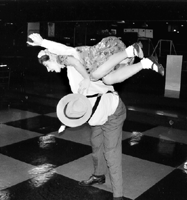
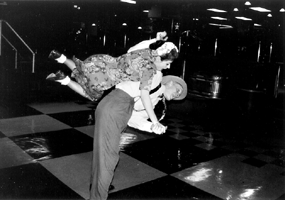
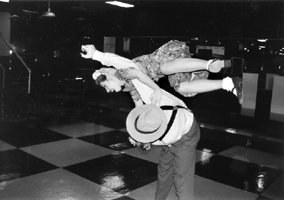
Any dancing offers those benefits. Swing dancing is more likely to deliver, according to Jennifer Gooding, the instructor who guided the dancers at Merritt, because it's not "as intimidating as other dances." Most swing moves are simple and can be quickly learned. For many dance novices, swing's informality adds to its appeal. It has none of the more formal gestures and movements of ballroom dances such as waltz or tango.
Swing's role as an entry into the social scene is not its only value. Gooding views this activity as a safe, healthy way for young people to socialize. "It's good for the younger people; it's its own drug," she says.
Speaking of drugs, at most swing events you'll find fewer smokers and a lot less consumption of alcohol. You can't manage the aerobics if your lungs are full of smoke; you can't carry off the intricate movements and keep your balance if you've had more than a couple drinks. You'll find yourself sprawled rather than dancing on the floor. This is not to say that club venues are smoke-free, but the air is a bit clearer on swing nights.
Partners Aplenty
Swinging in the '90s is different than in the '70s or '80s. Times have changed, and young people in particular are in step with the times -- at least when it comes to dancing. Dance styles of the '70s or '80s emphasized the individual rather than the couple. Hands seldom touched; your dance partner was almost irrelevant. Clubs were crowded with young adults barely interested in the social exchange of dancing.
Walk into Club Hollywood in Annapolis on a Monday night. You'll usually find over 100 dancers ready to swing the night away to one of the area's Big Bands. The ages of the dancers range from the 20s to the 60s. All share the same infatuation with dance. The gray-haired couple who've been dancing together for decades spend their Monday nights on the same dance floor as the 25-year-old professionals and the 40-year-old parents trying to stay connected. They all gather to learn and share the pleasures of swing dancing.
John and Samanta Sargent, Club Hollywood's swing instructors from Baltimore, lead the newcomers through a fun-crammed half-hour lesson. During the lesson, John makes sure that everyone changes partners a few times so dancers meet their fellow beginners. At the end of just 30 minutes, you've learned enough East Coast moves -- from the basic single step to the gentleman's underhand turn -- to enjoy yourself and hopefully to delight your partners.
 Speaking of partners, you'll need one. Fortunately,
they're not hard to find.
Speaking of partners, you'll need one. Fortunately,
they're not hard to find.
"It's not a meat market; it's social," says Matt Marshall of Annapolis, who's making the Monday night dances a habit. Neatly dressed in a button-down shirt and casual trousers, Matt is new to the area but not new to swing. He's looking for a regular dance partner so he can practice the steps he's learning each week. In the meantime, however, he's finding plenty of women eager to dance.
That's one of the beauties of swing dancing. It's the activity -- the social dancing -- that draws people. John Sargent summed it up at the end of his East Coast swing lesson: "Remember: the most important part is to be social. Dance, have fun and ask a stranger to dance."
You'll find that everyone, even the most talented dancer, was once a beginner. I've shared some of my most enjoyable dances with dancers much better than me. I've gone up to a guy and said, "I'm a beginner but I'd like to dance with you" Most were delighted to dance with a newcomer.
Those who are just cruising the clubs looking for a mate and who aren't interested in the dancing aren't going to make it.
That's not to say, however, that you can't find someone special out there on the dance floor.
For those who have partners off the dance floor, swing dancing can be a new way to get together. That's been the experience of Helaine and Nathan Betnum of Annapolis, who learned the basics of East Coast swing at Merritt. Their children are grown and out of the nest. Helaine explained that it had been "Nathan's desire to find something we could do together, to connect, now that the children were gone."
The Betnums intend to stay fit and have fun doing it. Helaine and Nathan left the dance a little sweaty, a little more skilled and determined to keep swinging. They had connected with each other in a new way.
Shall We Dance?
So you've built up enough courage to go out to a swing dance or swing night at a local club. What now? Who do you dance with? How do you act?
Most importantly, you dance with everyone and anyone -- at least once. Swing dancing takes concentration and it takes commitment: it's an acquired skill. One of the best ways to gain that skill is to "dance around.' Every partner is different, with his or her own way of moving. A good dancer can dance with anyone. But getting there takes time, practice and being open to dancing with lots of people.
There are, unfortunately, a few dancers to avoid. At the top of ladies' lists are the men who don't respect arm sockets and fragile wrists. They are the guys who push, pull, yank, and jerk your limbs. These guys may get a first dance with a lady, but that's about it. Pain encourages ladies to avoid the gents creating it.
Gentlemen say they avoid the ladies who try to lead. One of the fundamentals of swing dancing is that the gentleman leads and the lady follows. (Thus the dancing adage: The man is always wrong.) Dancing with a lady who tries to lead just doesn't work.
On the other hand, there's no prohibition against women asking men to dance.
One other category of dancers you may not be comfortable with are those who take their dancing a bit too seriously. Some people call these folks the 'fifis' or the 'dance Nazis.' You'll recognize them: very little eye contact; no smiling, please; a few too many recommendations for your improvement. Fortunately, there are enough of these dancers around that they can find partners among their own ilk. Besides, unless you're one of them, you'll get but one shot with these serious swingers.
Have you noticed that these dancers are 'ladies and gentlemen?' That's who most swing dancers are. One of the splendid aspects of this retro-dance craze is that today's swing dancers are polite and civil. They're even civil to the dancers they want to avoid. If they say, "no, thank you' to that guy who could twist a shoulder or woman who resolutely leads, they sit out that dance.
Courtesy is one of the ways today's swing dance scene reminds Annapolitan Michael Klein of his earlier swing-dancing days. Klein is a member of swing dancing's first generation come back to the dance floor. At a recent Monday swing night at Surfside 7, Klein spoke about his days as a young man in New York City during World War II:
"We'd go to a dance hall where the women were all sitting in chairs in a large circle. We'd go down the line until we saw someone we wanted to dance with. We'd go up and say 'would you care to dance.' If they said, 'No thank you,' you'd go to another one. After the dance, you'd always say thank you and escort them back to their chair."
Perhaps it's his generation's civility that adds that special sense to the culture of swing dancing. For one of the first things you notice when you walk into a swing dance is the civility of it all. The music is melodic, the clothes neat, people's demeanors polite as dancers rediscover the joys of being ladies and gentlemen.
Dressed to Swing
One of those joys is dress. The fashion of the '30s and '40s are reappearing on '90s dance floors. Devotees of Lindy Hop in particular add to their pleasure by dressing the part of 1940s swingers.
On the feet of these energetic dancers you'll notice two-tone wing tips,
saddle shoes or Mary Janes. Gents are wearing braces, otherwise known as
suspenders, to hold up the pants of their Zoot suits. Ahh, the Zoot suits:
those dapper suits with the long double-breasted jackets and the high-waisted,
pegged and pleated trousers. The ladies are bringing back the wonderful
'40s look in their rayon dresses with seamed bodices, wide shoulders and
swingy skirts. Bobby socks are in again, too.
Vintage clothing stores are reaping profits galore from the resurgence of swing dancing. Various Web sites offer Zoot suits, shoes, skirts and underwear, all purchased by the newly enchanted as well as the long-term swing dancers. Yes, underwear. Swing skirts fly in all directions -- including up -- during those aerials.
The less entrenched swing dancers are content with less authentic '40s wear. You'll do just fine in a comfortably fitting swirly skirt or dress, a pair of loose trousers or, a la Gap, a pair of khakis.
The one crucial accouterment for anyone spending much time on a dance floor, however, is a good pair of dance shoes. Imagine trying to spin on a wooden floor (the very best surface for dancing) while wearing rubber-soled athletic shoes or slick leather soles. You'll either not be able to move or you'll slide out of control. The solution: dance shoes with soles of either felt or a new synthetic "rubber' that is spinable. If you're serious about swing dancing, you'll save your pennies and treat yourself to real dance shoes as soon as you can.
Got to Have Music
"And here, ladies and gentlemen, is one of the greatest swing tunes ever written." That's how the leader of the Chesapeake Greys Big Band introduced "In the Mood" to his appreciative dancing audience at Club Hollywood. Glenn Miller's legendary arrangement works as well today for a medium-tempo East Coast swing as it did in swing's golden days of the '30s and '40s.
Annapolitan Matt Marshall took a breather from Club Hollywood's dance floor to describe what the music adds to the experience: "The special feeling of being in sync with the music is like a runner's high or like skiing down a slope. You have to have good music." Being in sync with the music (and with his partner) brings him repeatedly to the dance floor.
To sample old favorites: Louis Jordan, Glenn Miller or Benny Goodman.
They're treasures for all swing styles. For those hardy soles and lungs,
try dancing to "Sing, Sing, Sing." My Benny Goodman CD has a rendition
of this Lindy hopping tune that runs eight minutes, 38 seconds. Its length
makes it a favorite for a 'jam,' where couples take turns performing while
other dancers cheer them on.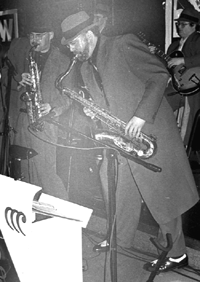
West Coast swing wants a slower beat than jitterbug or Lindy, giving the dancers time to throw in syncopations or fancy footwork patterns. Rhythm and blues tunes of the '50s or more recent R&B performances pulse with that slinky, sultry tempo perfect for this swing style. R&B oldies also maintain the perfect beat for the flashy and complex movements of DC Hand Dancing.
Dancers are swinging to new music as well as to old. Brian Setzer, a favorite contemporary swingmeister, penned new swing tunes such as "The Dirty Boogie" and "Rock This Town." (But it was Setzer's rendition of Louis Prima's classic "Jump Jive an' Wail" that garnered him a Grammy this year.) Half-time entertainment at this year's Super Bowl highlighted Big Bad Voodoo Daddy, another popular neo-swing band. The Squirrel Nut Zippers and the Cherry Poppin' Daddies attract devotees as much for their danceability as for their musicality. Huge music retailers like Borders and Barnes & Noble are adding listening stations featuring both old and new swing music selections. Clearly, modern swing has carved its own niche.
Big Band, Motown, R&B: There's something for everyone's musical tastes out on the dance floor. You may even develop a new taste or appreciation for music you've never heard before.
The dancers at Club Hollywood eagerly erupted into cheers and clapped their hands when the Chesapeake Greys started playing "In the Mood."
A Moment in Swing
On a recent Monday night at Club Hollywood, I had just about the perfect swing experience. Even before the music started, I fell in love with the band. All 18 members of Mood Swings were wearing bright red Zoot suits and fedoras. There was lots of brass. The scene visually stunned me.
Then the music started. We danced to "String of Pearls," "Pennsylvania 6-500," "Don't Sit Under the Apple Tree with Anyone Else but Me," "Sing, Sing, Sing" and, of course, "In the Mood." Jack Vaeth, CEO of Mood Swings, suggested that if we didn't recognize that song, we might be in the wrong place. Everyone knew it. Lindy hoppers hopped; jitterbuggers jittered; beginning swingers relaxed and just swung. Swing euphoria swept over everyone on the floor.
When the endorphins kick in, you're in syncopation with your partner, with the music: you've got a dancer's high.
A couple of hours later, Vaeth asked "Have you had enough?" The floor was somewhat emptier, but the hold-outs wanted more. More was given, until finally we all had to go home; it was Monday and we did have work the next day. We pulled coats over hot sweaty limbs. We walked to the parking lot tired yet exhilarated with every muscle awake. It's addictive.
On the way home, we debated: Chunky Monkey or Cherry Garcia?
Where to Dance
The best way to start swing dancing is to take lessons. Many venues give free lessons; check out the list below for some suggestions. Some county recreation departments offer low-cost lessons in social dance, including swing. On the listed Web sites, you'll find for more information about this sociable way to have fun and exercise at the same time. Call ahead to confirm dates and times.
The Romance of the Dance
Back in 1944, in a small town in Pennsylvania, a young man and woman met on the dance floor of a hangout called the Shady Nook. It was World War II, the jitterbug era. Bill and Arline courted on the dance floor, fell in love, married and had two daughters. They continued to dance, never losing their joy in movement.
My mom and dad were absolutely the smoooothest jitterbuggers! They taught me how to dance and passed on to me their love of swing dancing. Swinging with my dad at a family wedding or the local fire hall on a Sunday afternoon was one of my favorite pastimes as an adolescent and young adult.
They were my first but not my only influence. Growing up in the "60s in the Philadelphia area meant that when I'd get home from school, I'd turn on American Bandstand and practice my jitterbug -- with a door handle as my partner.
I never really left the dance floor, continuing to learn new dancing styles over the years. Fifty years after my parents met, I met Jonathon (introduced by a mutual friend) on the fringes of a dance floor in Virginia. We were both into West Coast swing. We connected on the dance floor, then off the dance floor. We danced. We married. And, ladies: I asked him to dance.
-DA